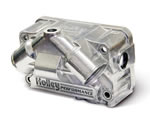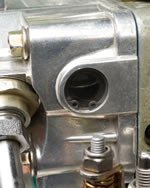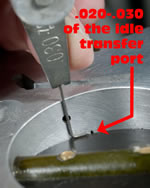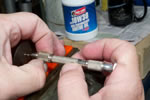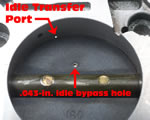Hib Halverson's Big Block From Hell Series
 |
 |
by Hib Halverson
© December 2012
Getting Started
First change I made were stainless steel carb studs, nuts and washers (PN 400-2403) from Automotive Racing Products (ARP). The ARP studs have rounded ends which make carb removal/replacement easier. ARP's stud kit is designed for spacers up to 1/2-in. so it works with the Holley heat shield assembly (PN 108-70) I have.
Next, came Holley's new, aluminum float bowls (PN 124-175, 134-175) which are lighter and have sight glasses rather than plugs for setting float level. Along with less weight and less messy float adjustments, I got a snazzy, polished aluminum finish. Sweet!v
My first adjustment was to set the floats. Not only does proper float level prevent flooding or starving for fuel, it affects timing of the main circuit. It is critical to set float level with the car on a level surface. Holley's aluminum bowls require a different adjustment procedure than bowls with sight plugs. Base float level should be halfway up the sight glass. If you have bowls with plugs, set the float level at the bottom of the holes.
A 4150 uses two circuits to control part-throttle air-fuel ratio (AFR): "idle transfer", which starts just off-idle and provides fuel at low part-throttle and light load and "main", which influences medium part-throttle AFR at light-to-medium loads. Initial road testing with the AutoMeter wideband showed the part throttle AFR was way rich and that our accelerator pump calibration—we'll cover that later—was too rich, as well. No wonder the Big Block from Hell was a gas-guzzling pooch around town.
The first step in solving the rich part-throttle problem was to optimize the relationship between the primary throttle plates and the primary idle transfer ports. If that's not right, you may have trouble adjusting idle mixtures, throttle response problems and may make incorrect choices in idle feed restriction sizes and accelerator pump calibration.
Remove the throttle body. Adjust the primary idle screw so the first 0.020-0.030 of the primary idle transfer slots is visible. Reassemble the carb, run the engine and get the idle mixture screws close. If idle is too high, the fast idle cam might be enabled or sticking or there is a vacuum leak. Address those issues then try again.
If idle speed is a little too low, adjust the speed screw a small amount—say 1/3 turn or so—until you have the speed you want. If idle speed is a lot too low, pull off the throttle body and drill bypass holes in each primary throttle plate to allow more air through the primaries without disturbing the relationship between the plates and transfer ports. Using your pin vise, drill the plates on the same side of the throttle shaft as the transfer ports. Start with a 1/16" hole in each plate and work up a drill number at a time until idle speed is about what you want. You can fine adjust the idle speed screw, however, more than a third-to-half a turn either way might have the plate/slot relationship out of whack and you'll have to increase the bypass hole size. If you drill the holes too large, plug them with epoxy and redrill smaller. Durability? I ran this old hot rod with epoxied/redrilled plates for 20 years until I wrote this article with no problems. So they'd look pretty in photos, I ordered new throttle plates (PN 26-97) from the Carb Shop and drilled them right this time.
 |
 |
